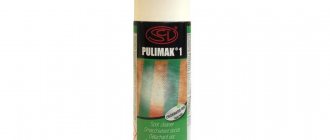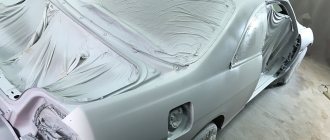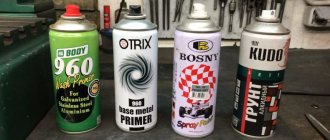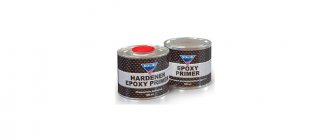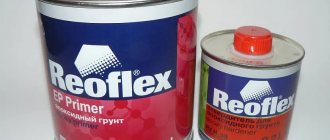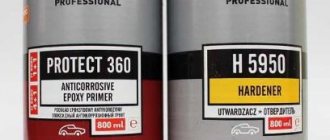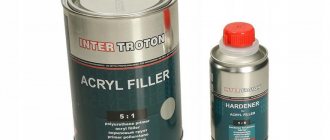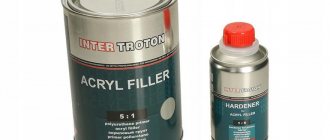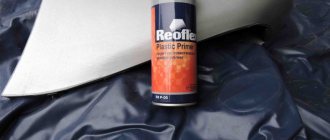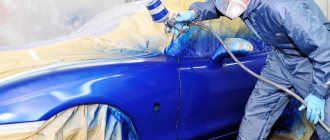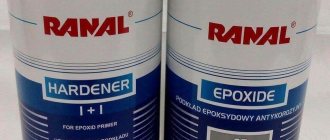What is oxygen primer for a car?
An acid-based primer is a special primer that comes in cans or containers with liquid. The main application is to improve adhesion and anti-corrosion protection.
The product is suitable for treating car bodies and is used as an initial layer.
It is impossible to apply a paint coating or epoxy composition over this product, since additional painting suppresses the acidic properties of the primer.
Primer for plastics
Primer for plastic is an adhesive primer, or “Primer for plastic”, which is used when painting plastic. Their main task is to adhere to the surface of the plastic and become an adhesive substrate for subsequent coatings. Primers for plastic are always 1K - one-component compositions. They are often called "plasticizer". They do not require dilution and are in finished form, mostly transparent and slightly yellowish in color. Basically, plastic primer is suitable for all types of plastic. Of course, there are difficulties with polypropylene and polyethylene PP, PE. So, read the compatibility instructions on the jar before purchasing. If the new plastic part is not primed, then according to the technology, before applying a primer to it, it must be heated at a temperature of 50 degrees. Within 30-40 minutes. During this time, the silicone (it is used to lubricate molds during bumper stamping) rises to the surface, where it is removed with a degreaser and a napkin. In garage conditions, this can only be done in hot weather, by placing the part in the sun. An alternative is to simply wash the part in warm, soapy water. Primer for plastic Reoflex aerosol is a one-component primer in a can, designed to improve the adhesion of paintwork to plastic. Apply in one thin layer. Acrylic materials and base coats can be applied on top. The following companies are also common: Body, Kudo, Novol.
Problems when priming a car
The main defects that occur during priming are subsidence and calving. After applying the secondary primer, the putty areas are often contoured. Contouring is the manifestation of the boundaries of the putty area under subsequent coatings. This is a very unpleasant and clearly visible defect. It may not occur immediately, but several days after painting. It occurs due to the fact that polyester putties shrink already under the paint, as a result of which the border of the putty area becomes visible. Subsidence (shrinkage) is a gradual decrease in the volume of putty during the curing process. Absolutely all putties are subject to subsidence, regardless of their type and manufacturer. Shrinkage may be less or more for different brands, but it will definitely happen. Reasons for contouring:
- If under the putty there was not pure metal, but an old paint coating.
- If there was little time for final shrinkage to occur.
The putty dries in 20 minutes, but nowhere is there any indication of the time required for complete shrinkage. Practice shows that final grinding under secondary primer is ideally carried out within 24 hours. The thickness of the soil should be such that there is a reserve for grinding the contoured area. Sometimes the filler is applied in a much thicker layer, this is when the master is already tired of puttingty and wants to compensate for the defects with a thicker layer of primer. In this case, it is necessary to take into account that the soil also shrinks. The only way to combat this phenomenon is time. The conclusions are as follows:
- Recycled primer should not be applied in a layer of excessive thickness. There are liquid putties for this.
- The final shrinkage of the applied materials takes time.
- Remember previous and subsequent coverage.
If you have any questions, ask them in the comments, I will be happy to help. Good luck in job! Site Map
All about painting
- Body repair theory
- Tools and equipment
- Painting materials
- Polishing workshop
- Plastic repair
- Painting in practice
Main varieties
You can find 2 types of acid soil on sale:
- Based on 1 component.
- Based on 2 components.
One-component
Phosphate primer based on 1 component can be used without prior preparation. It can be purchased in cans for application without auxiliary equipment or in containers with a liquid solution. The second option is applied with a spray gun in 1 thin layer. When the coating acquires the required properties, it can be treated with acrylic with the inclusion of a hardener.
Two-component
Before applying the product to a metal surface, it should be properly prepared. The instructions mention the need to mix the main substance with the activator. The final consistency takes on both hard and soft forms. Experts advise choosing the first option, as it creates a strong and reliable film over the entire treated area. It is allowed to apply primer in 1, 2 or 3 layers, observing the proportions and basic recommendations of the manufacturer. There is a 5 minute pause between reuses.
Technical characteristics and features of Novol reactive primer
Novol Protect 340 is a two-component reactive (or acidic) primer, free of chromium salts, which consists of the following components:
- suspension of pigments and filler in a mixture of high-quality resins;
- hardener based on orthophosphoric acid.
The reactive composition is applied directly to the rust source and is primary. This means that it cannot be painted immediately. A layer of secondary primer is always applied over the acid primer. The Polish product Novol Protect 340 is an ideal base that guarantees strength and excellent adhesion of subsequent layers. It has excellent technical characteristics:
- high strength and wear resistance;
- resistance to salts;
- excellent hydrophobicity;
- good adhesion;
- resistance to mechanical stress.
The acid composition Novol Protect 340 can be applied to aluminum, nickel-plated, chrome-plated, galvanized steel.
It is important to remember that the mixture is highly flammable and highly toxic. The material is easy to use; in order to apply it to the surface with your own hands, you do not need special knowledge and skills. The instructions for use will help you do this quickly and efficiently.
Pros of primer in cans
Primers in the form of aerosols have several important advantages:
- Ease of use. There is no need to use special equipment to distribute the soil.
- High quality finishing coating. The can ensures uniform distribution of the composition over the surface being treated.
In most cases, an aerosol primer is used for local application to metal products.
If you need to treat large areas, it is better to use an air gun.
Primer in the form of a spray is used by beginners who have not carried out body repairs before. Using an aerosol, you can level paintwork materials and get an even and beautiful coating.
Acid Primer Application Methods
There are several ways to process a car body:
- Using a brush.
- By spraying an aerosol.
- By immersing the metal in a primer solution.
- By spraying using electricity.
- Electrodeposition. The process is based on the principle of electrophoresis. The product that needs painting is placed in a container and acts as a charged element of the circuit (positive or negative).
Important! Dipping into a primer is applicable only in factory conditions.
When working with acidic soils, certain precautions should be taken, since they contain unsafe chemical components.
The primer is applied before painting and may or may not be sanded. The use of high-quality materials, strict adherence to procedures and the qualifications of the performer directly affect the level of protection of the treated body from corrosion.
Polyvinyl-butylene, which is part of the materials used, helps prevent rust. The primer is used to cover surfaces made of:
- aluminum;
- of stainless steel;
- ordinary metal;
- galvanized steel.
Preparation stages
To obtain a high-quality surface, you should perform a number of preparatory actions and adhere to a strictly proven algorithm:
- First of all, you should prepare the room in which the body will be painted.
- Then you need to clean the surface from rust, dirt, dust and old putty.
- Next you need to inspect the machine and prepare a suitable enamel composition.
- After this, it is necessary to protect the body parts that do not need to be treated and degrease the surfaces.
- At the next stage, putty is applied and an anti-corrosion layer is formed.
Preparing the body for priming
To obtain the desired quality result, the painting work itself must be carried out according to certain rules. Experts say that you need to use the following technology:
- They start by preparing the room where the body will be painted. It is necessary to clean it, wipe off the dust so that it does not settle on the surface.
- Then they prepare the car itself, remove the old coating completely, reaching the metal coating directly.
- You should inspect the car after this to determine the future enamel.
- Elements of the machine that do not need to be painted are covered.
- It is necessary to degrease the base.
- Sand the surface.
- Putty is applied.
- The product is applied.
To carry out the stages of cleansing and degreasing, a brush or aerosol products are suitable. When the second option is chosen, the coating will be smoother, which simplifies the process of applying reactive primer.
Work must be carried out wearing protective equipment. The master must wear a respirator, protective gloves and clothing, and shoes must be tight.
Reactive primer allows you to create a reliable coating that will protect the metal base from corrosion.
Reactive primer allows you to create a reliable coating that will protect the metal base from corrosion.
Application methods
Acid primer can be applied using several methods and tools:
- Simple brush.
- Spray gun.
- By lowering a metal product into a solution.
- Electrical spraying.
- Using electrodeposition technology.
In everyday life it is customary to use the first 2 tools. Immersion technology is used in factories.
Is it possible to apply paint to acidic soil?
Experts do not recommend applying paint over a layer of one-component acid primer. Otherwise, the components may cause a change in the shade of the paint due to the action of the yellow pigment.
What is the peculiarity of the composition
Acid primer for cars is a strong substance that ensures sufficient resistance of the frame to moisture and helps destroy rust. To completely remove rust before applying paint, it is recommended not to skimp on primer and buy a product from trusted brands.
The acid primer is based on phosphoric acid and a zinc additive. The product is applied exclusively as the first layer, that is, sprayed directly onto the metal. Before use, the surface must be degreased, this will help remove particles of rust and grease. Drying time at room temperature (20 °C) is 15 minutes.
When the composition has completely set, you need to additionally walk over the area with an acrylic primer. It helps to even out the layer. It is better to apply the composition to the seams with a brush. If you need to treat large areas, you should choose a spray bottle.
Acid primer is a mixture of phosphoric acid and zinc, it is primary and is sprayed directly onto the bare metal
Important! Do not apply the composition to old putty or poorly cleaned metal, otherwise the subsequent coating will peel off over time. Acid primer is applied only to clean, degreased metal; if there are old coating particles, you can use acidic epoxy primer.
In each case, the substance requires subsequent coating with a 2-component primer and filler. When high-quality preparation has been completed, you can begin coating with an additional layer of primer, putty and paint.
You cannot apply other compounds directly to the acid coating, the only exception being an insulating primer. Etching is a critical vehicle prep and treatment procedure to ensure metal integrity and corrosion protection. Welding seams are always coated with the substance.
Rating of the best brands
When choosing which primer to buy for a car, you should familiarize yourself with the following product brands:
- DUR 1:1. The reactive solution provides a durable film with improved adhesive properties. The advantage of the composition is the absence of chromates and the presence of a special reaction catalyst in the kit.
- Body 960 Wash primer. Suitable for different surfaces and consists of 2 components. During application it is mixed with hardener.
- Mobinel. A one-component product with high anti-corrosion characteristics. Suitable for stainless steel, galvanized and aluminum.
How to prime a car body
If you plan to work with small defects, a spray can is quite suitable. The primer in a metal can must first be mixed with a solvent and, if necessary, a hardener. The latter is necessary if a one-component type of product is used.
The substance must be thoroughly stirred until smooth. The hardener must be added in stages, depending on the number of layers applied.
The composition must be diluted strictly as written in the instructions. You need to apply the substance with a roller or brush; you can also use a spray gun. The primer is applied with a brush or roller, taking into account the following rules:
- the first layer is very thin;
- After 15 minutes you can apply the second layer, and after another 15 minutes the third layer. Without reference to a time interval - you can apply a new layer when the previous one becomes matte;
- you need to apply the substance smoothly, but without staying in one place for a long time;
- Avoid abrupt transitions and gaps.
Using a spray gun, apply the primer as follows:
- the first layer should be thin and even, so the distance from the surface to the sprayer should be 20–30 cm;
- In order for the substance to be evenly distributed over the surface, the movements must be cross.
With this technology of applying the substance, there may be smudges and other minor defects, which can be easily removed by sanding before painting.
The room where the car surface is being primed should be free of dust, drafts and dirt. It is better if the lighting is daylight spectrum, of moderate brightness.
If you plan to prime not the entire car, but only individual parts, the “non-working” areas must be covered with film and masking tape. The windows and headlights must also be covered.
Important! Do not forget about personal protective equipment while working!
Is it possible to apply epoxy primer to gravitex?
We sharpen the putty by hand using a long grater: We start with 120 abrasive and finish with 220.
8. Sand the entire part with an eccentric, abrasive 220 9.
Which is better: heated floors or radiators?
Warm floorBatteries
Apply a thin layer of epoxy primer to the areas that have been worn down to iron. 10. Apply liquid putty, 3-4 layers, to combat contouring.
11. Is it possible to mix red and yellow atf? We sharpen the liquid putty with 220 abrasive and a long float, using grinding detectors. 12.
We sand the liquid with an eccentric, abrasive 320. As can be seen from the list, the epoxy primer is applied twice - before applying the putty, and after grinding, on the areas rubbed to iron. Epoxy primer and liquid putty need not be applied.
The puttying procedure is as follows, after washing, degreasing and stripping: 1.
Automotive primers and their application.
Primer is a special composition that is applied to the surface of the car before applying the paintwork.
The soil has a high content of pigments. The main function of the primer is to improve adhesion (adhesion) with the subsequent layer of paintwork. When repairing a car body, they usually prime the putty repair area, which also has fragments of the old paintwork. Pure metal also needs to be primed. Thus, auto enamel is applied to the primer or to the old paintwork (provided that the old coating is compatible with the applied enamel).
Soils have different compositions and, depending on this, have different properties.
Anti-corrosion (“acid”) primer:
It is applied to clean metal and protects it from corrosion. This is a primary primer and must be coated with a secondary primer, that is, putty or paint cannot be applied to it immediately. It is always recommended to cover the “bare” metal with an anti-corrosion “acid” primer. If the metal of the new body panel is coated with high-quality factory primer, then “acidic” primer is not used.
Epoxy primer
Epoxy primer is intended for anti-corrosion protection of metal surfaces. Just like acidic soil, it is primary. For further painting of the surface, it must be covered with secondary primer. It is worth mentioning here that epoxy primer sprayed onto a flat (without minor defects) surface can be painted even without sanding paper. But this can be done before it has completely hardened, several hours after priming. If the primer has hardened, it must be treated with sanding paper and primed with acrylic primer. Then dry the acrylic primer, sand it for painting and then you can paint.
Epoxy primer contains special resins and special active additives that prevent the development of corrosion processes on the metal surface. It dries quickly and after curing becomes resistant to mechanical and temperature influences. The surface covered with this primer, even without applying paint and varnish materials, is well protected from corrosion.
Epoxy primer after application forms a dense film that does not have pores.
The disadvantage is the long drying time. At a temperature of +20 °C it averages 12 hours. An increase in drying temperature leads to uneven polymerization of soil layers and leads to the appearance of defects.
Two-component pore-filling primer:
This primer is most often used before painting a car. Porosity-filling primer can be applied in a thick layer. It fills the pores that remain on the putty, as well as the marks left by sanding paper.
However, you need to remember that the putty surface must be prepared for priming according to all the rules and the risks from sanding should not be too large. If you fill too deep scratches with this soil, then after some time, after drying, the soil will sag and all defects will be visible.
One-component nitro primer:
Apply before painting with alkyd or nitro enamels. This primer is not compatible with acrylic car enamels or metallic paints. The main advantage is that it dries very quickly.
One-component acrylic primer:
It is convenient to use as it comes in an aerosol package. But it is also sold in regular containers.
Sufficiently high quality soil. Dries quickly and is easy to use. Compatible with almost all types of paints.
Primers for plastic:
When repairing plastic, special primers are used to increase adhesion. If you are painting new plastic, then after priming with a special primer you can immediately apply paint.
Application of primer:
Before spraying, the primer must be thoroughly mixed, and in some cases, if necessary, diluted with a thinner to a working viscosity. When diluting different soils, you need to check the instructions for each specific product.
It is forbidden to dilute with solvents to the working viscosity; only thinners must be used.
Next, it is important to filter the soil.
For application, primer spray guns with a nozzle of 1.5 - 2.0 mm are usually used. Apply 1 – 2 layers. If desired, you can apply more layers, taking into account the fact that in preparation for painting, part of the primer will be sanded off. But you need to remember that it is not recommended to apply a layer that is too thick, especially since it will not dry well. Each layer must be applied after the previous one has dried. Interlayer drying time is approximately 10 – 15 minutes.
Preparing the surface for applying primer: - clean from dust; — before priming, plastic parts must be wiped with an antistatic agent; - degrease the surface.
Ground grinding:
When sanding dry before painting, use P400. When preparing with water, P800 is used. In areas of panels that have a complex shape, as well as in hard-to-reach places, you can use Brite tape.
Should I work dry or with water? Water is a source of corrosion, and some primers are designed for dry sanding only. The advantage of working with water is the absence of dust. Also convenient to use sanding paper. It clogs less and if it does clog, just rinse it with water. When working dry, you can use a sander to speed up the work. And, most importantly, the risk of corrosion is reduced.
A reasonable solution can be considered dry sanding using water in inconvenient places. Bumpers can be easily sanded with water, making sure to dry thoroughly before painting.
It is better to use a primer color similar to the color of the applied paint. This will make it easier to cover the repair area. You can also tint the primer to match the color of the paint.
A light gray color can be considered universal; it will match any paint color.
